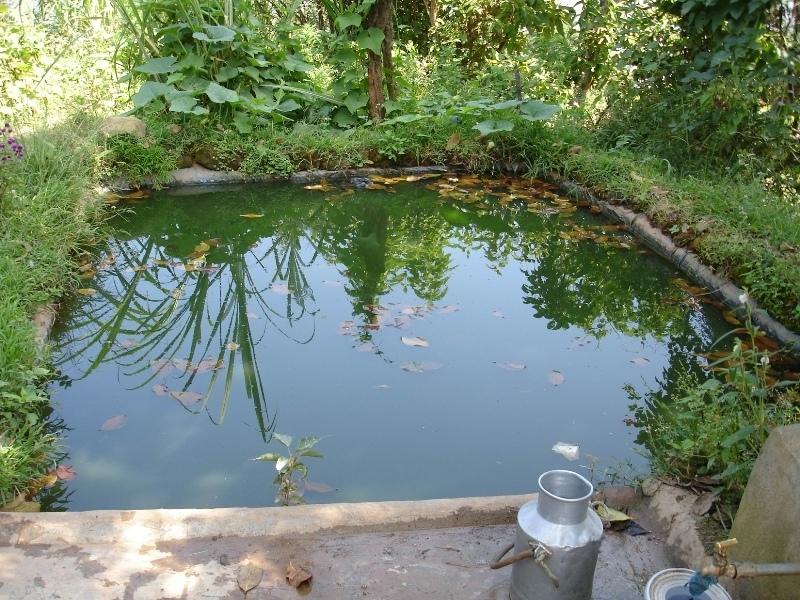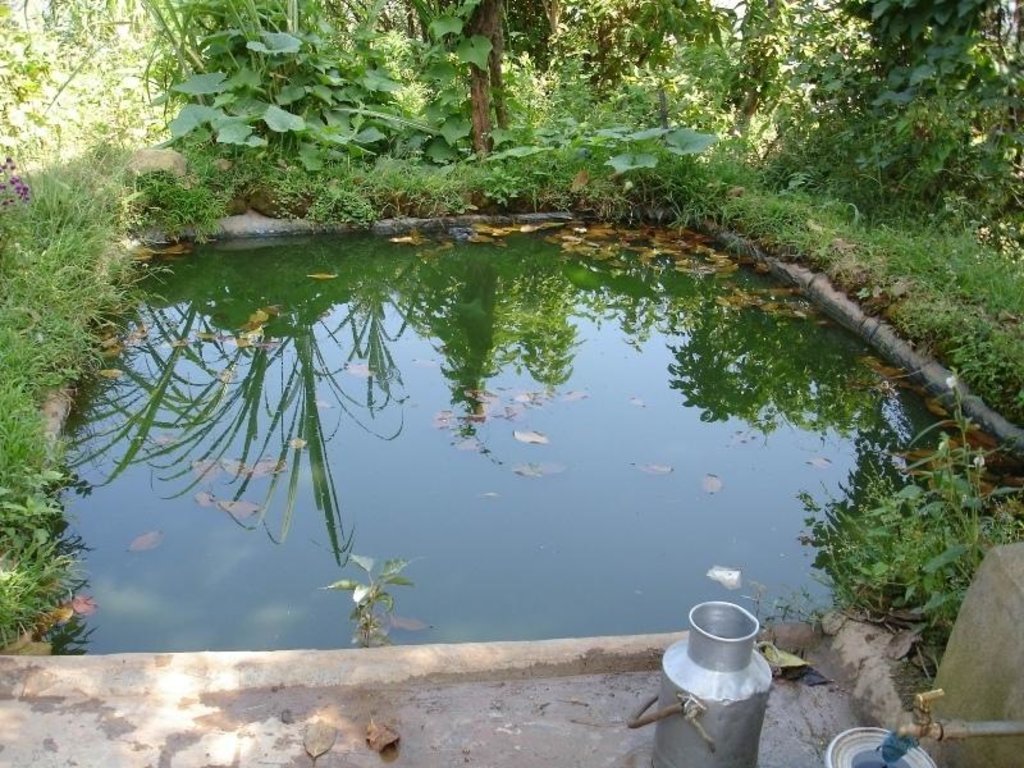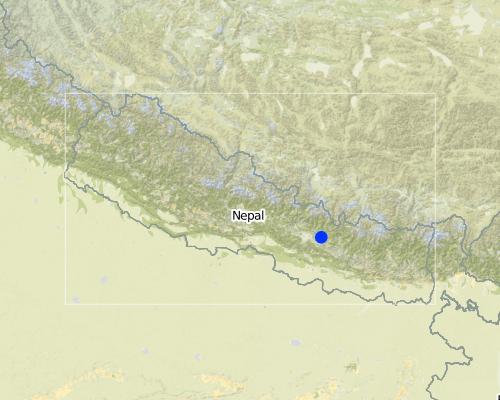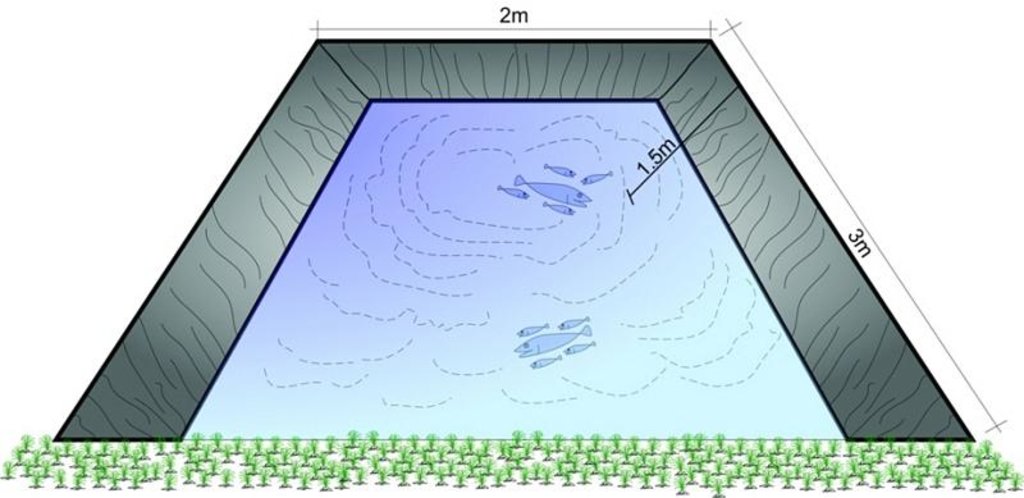Plastic-lined conservation pond to store irrigation water [Népal]
- Création :
- Mise à jour :
- Compilateur : Madhav Dhakal
- Rédacteur : –
- Examinateur : David Streiff
Plastic bichchhayeko Samrakshan pokhari - Nepali
technologies_1462 - Népal
Voir les sections
Développer tout Réduire tout1. Informations générales
1.2 Coordonnées des personnes-ressources et des institutions impliquées dans l'évaluation et la documentation de la Technologie
Spécialiste GDT:
Nom du ou des institutions qui ont facilité la documentation/ l'évaluation de la Technologie (si pertinent)
ICIMOD International Centre for Integrated Mountain Development (ICIMOD) - Népal1.3 Conditions relatives à l'utilisation par WOCAT des données documentées
Quand les données ont-elles été compilées (sur le terrain)?
30/11/2006
Le compilateur et la(les) personne(s) ressource(s) acceptent les conditions relatives à l'utilisation par WOCAT des données documentées:
Oui
2. Description de la Technologie de GDT
2.1 Courte description de la Technologie
Définition de la Technologie:
A plastic-lined dugout pond to store runoff and household wastewater for irrigation purposes during dry periods
2.2 Description détaillée de la Technologie
Description:
Water harvesting technology is very useful in areas where there is limited rainfall for long periods of the year. These dry periods severely limit the growing of crops across Nepal’s middle mountains especially on steep slopes where conventional irrigation can be difficult to arrange. Plastic-lined conservation ponds store water for irrigation more efficiently than the traditional earthen ponds which lose much water to seepage.
The ponds are dug out and the earthen walls lined with high density polyethylene (HDPE) sheet or SILPAULIN (multi-layered, cross laminated, UV stabilised) heavy duty plastic sheeting. The size of the pond will vary depending on the area available and the soil characteristics. The PARDYP project tested and demonstrated plastic-lined ponds with a capacity of 8,000-10,000 litres. These ponds were about 3m long, 2m wide and 1.5m deep and were located at shady sites to minimise evaporation losses.
The conservation ponds tested and demonstrated by the PARDYP project were used for irrigating high value off-season horticultural crops (vegetables, fruit, and spices). These crops were irrigated with drip irrigation and micro sprinklers (see sheets QT NEP6 and QT NEP21). The ponds were fed from rainwater, upland springs and taps, and household wastewater.
The ponds were established during the dry season in three days. They were prepared by selecting a suitable site with a sufficient catchment; mapping out the area and depth of the pond; digging out the soil; removing protruding stones and roots; and compacting and smoothing the sides and bottom of the pond. Then the sides and bottom of the pond were lined with sieved soil followed by plastic sheet, which was anchored by stones and soil.
The main maintenance activity is to prevent livestock and people from entering the pond to avoid damaging the sheet. The pond should not be allowed to dry up as this would let rats damage the sheet. The sediment that accumulates in the pond should be removed once a year carefully by hand only as the use of agricultural tools could puncture the sheet.
2.3 Photos de la Technologie
2.5 Pays/ région/ lieux où la Technologie a été appliquée et qui sont couverts par cette évaluation
Pays:
Népal
Autres spécifications du lieu:
Kavrepalanchowk district/ Lamdihi, Patalekhet, Chiuribot, villages of Jhikhu Khola watershed
Map
×2.6 Date de mise en œuvre de la Technologie
Si l'année précise est inconnue, indiquez la date approximative: :
- il y a plus de 50 ans (technologie traditionnelle)
2.7 Introduction de la Technologie
Spécifiez comment la Technologie a été introduite: :
- par le biais de projets/ d'interventions extérieures
Commentaires (type de projet, etc.) :
It is an ancient water management technique, later adapted according to the local condition.
3. Classification de la Technologie de GDT
3.1 Principal(aux) objectif(s) de la Technologie
- Improve water availability
3.2 Type(s) actuel(s) d'utilisation des terres, là où la Technologie est appliquée

Terres cultivées
- Cultures annuelles
Principales cultures (vivrières et commerciales):
major cash crop: Tomato and potato
major food crop: Rice and wheat
other: Mustard and legumes
Commentaires:
Major land use problems (compiler’s opinion): 1. Small landholdings which are mostly rainfed for cropping.
2. Low soil fertility status and high susceptibility to erosion.
3. Limited supplies of irrigation water and poor irrigation infrastructure.
Major land use problems (land users’ perception): The farmers experience serious constraints in terms of adopting better farming options, e.g., cash crops due to soil fertility and soil moisture problems.
Type of cropping system and major crops comments: Maize- wheat/ vegetables
3.3 Informations complémentaires sur l'utilisation des terres
Approvisionnement en eau des terres sur lesquelles est appliquée la Technologie:
- pluvial
Nombre de période de croissance par an: :
- 3
Précisez:
Longest growing period in days: 150; Longest growing period from month to month: Jun - Oct; Second longest growing period in days: 120; Second longest growing period from month to month: Nov - Feb
3.4 Groupe de GDT auquel appartient la Technologie
- récupération/ collecte de l'eau
3.5 Diffusion de la Technologie
Spécifiez la diffusion de la Technologie:
- appliquée en des points spécifiques ou concentrée sur une petite surface
3.6 Mesures de GDT constituant la Technologie

structures physiques
- S4: Fossés isohypses, trous
3.7 Principaux types de dégradation des terres traités par la Technologie

dégradation hydrique
- Hs: changement de la quantité d’eau de surface
3.8 Prévention, réduction de la dégradation ou réhabilitation des terres dégradées
Spécifiez l'objectif de la Technologie au regard de la dégradation des terres:
- réduire la dégradation des terres
4. Spécifications techniques, activités, intrants et coûts de mise en œuvre
4.1 Dessin technique de la Technologie
4.2 Spécification/ explications techniques du dessin technique
Plastic- linined conservation pond
Location: Patalekhet, Lamdihi and Chiurobot.. Kavrepalanchowk
Technical knowledge required for field staff / advisors: moderate
Technical knowledge required for land users: moderate
Main technical functions: water harvesting / increase water supply
Secondary technical functions: control of dispersed runoff: retain / trap
Structural measure: pond
Depth of ditches/pits/dams (m): 1.5
Width of ditches/pits/dams (m): 2
Length of ditches/pits/dams (m): 3
Construction material (earth): It is a earth excavated pit with earthen side walls
Construction material (other): plasitc sheet - Lining of a HDPE sheet or SILPAULIN (Multi-layered, cross laminated, UV stabilized p
4.3 Informations générales sur le calcul des intrants et des coûts
Spécifiez la manière dont les coûts et les intrants ont été calculés:
- par entité de la Technologie
Précisez l'unité:
Pond
Spécifiez le volume, la longueur, etc. (si pertinent):
3m long, 2m wide and 1.5m deep
Indiquez la monnaie utilisée pour le calcul des coûts:
- dollars US
Indiquez le coût salarial moyen de la main d'œuvre par jour:
2.10
4.4 Activités de mise en place/ d'établissement
| Activité | Type de mesures | Calendrier | |
|---|---|---|---|
| 1. | Select a preferably fl at site with a suffi cient catchment area | Structurel | dry months |
| 2. | Measure the area to be irrigated and estimate the size of the pond | Structurel | dry months |
| 3. | Measure and mark out the pond | Structurel | 1st day |
| 4. | Dig out the soil to the pre-determined depth | Structurel | 1st day |
| 5. | Remove protruding stones and roots | Structurel | 2nd day |
| 6. | Compacting and smooting the sides and bottom of the pond. | Structurel | 2nd day |
| 7. | Line the sides and bottom of the pond with sieved soil (preferably a clay | Structurel | 2nd day |
| 8. | Lay out the plastic sheets without any folds over the pond with | Structurel | 3rd day |
| 9. | Overlay thick fine soil on the plastic sheet | Structurel | 3rd day |
| 10. | Anchor the edges of the sheet at the rim of the pond with stones and soil. | Structurel | 3rd day |
4.5 Coûts et intrants nécessaires à la mise en place
| Spécifiez les intrants | Unité | Quantité | Coûts par unité | Coût total par intrant | % des coût supporté par les exploitants des terres | |
|---|---|---|---|---|---|---|
| Main d'œuvre | Dig out pond | persons/unit | 3,0 | 2,1 | 6,3 | 100,0 |
| Equipements | Plastic | unit | 1,0 | 29,2 | 29,2 | |
| Coût total de mise en place de la Technologie | 35,5 | |||||
Commentaires:
Duration of establishment phase: 3 month(s)
4.6 Activités d'entretien/ récurrentes
| Activité | Type de mesures | Calendrier/ fréquence | |
|---|---|---|---|
| 1. | Prevent livestock and humans from entering the pond | Structurel | daily/regularly |
| 2. | Ensure that the pond is not allowed to dry out completely as this could | Structurel | dry months./regularly, |
| 3. | Removing accumulated sediment once a year carefully by hand (using | Structurel | dry months./once in a year. |
4.7 Coûts et intrants nécessaires aux activités d'entretien/ récurrentes (par an)
| Spécifiez les intrants | Unité | Quantité | Coûts par unité | Coût total par intrant | % des coût supporté par les exploitants des terres | |
|---|---|---|---|---|---|---|
| Main d'œuvre | Clean and maitaining the pond | persons/unit | 3,0 | 2,1 | 6,3 | 100,0 |
| Coût total d'entretien de la Technologie | 6,3 | |||||
Commentaires:
Machinery/ tools: measuring tape, spade, shovel, knife, hoe, hammer, trowel, and pan
The cost given above is for unit technology having 9000 litre capacity as in 2006.
4.8 Facteurs les plus importants affectant les coûts
Décrivez les facteurs les plus importants affectant les coûts :
Cost of plastic, members of a household contributed as labour in all sites.
5. Environnement naturel et humain
5.1 Climat
Précipitations annuelles
- < 250 mm
- 251-500 mm
- 501-750 mm
- 751-1000 mm
- 1001-1500 mm
- 1501-2000 mm
- 2001-3000 mm
- 3001-4000 mm
- > 4000 mm
Spécifiez la pluviométrie moyenne annuelle (si connue), en mm:
1070,00
Zone agro-climatique
- humide
Thermal climate class: subtropics
5.2 Topographie
Pentes moyennes:
- plat (0-2 %)
- faible (3-5%)
- modéré (6-10%)
- onduleux (11-15%)
- vallonné (16-30%)
- raide (31-60%)
- très raide (>60%)
Reliefs:
- plateaux/ plaines
- crêtes
- flancs/ pentes de montagne
- flancs/ pentes de colline
- piémonts/ glacis (bas de pente)
- fonds de vallée/bas-fonds
Zones altitudinales:
- 0-100 m
- 101-500 m
- 501-1000 m
- 1001-1500 m
- 1501-2000 m
- 2001-2500 m
- 2501-3000 m
- 3001-4000 m
- > 4000 m
5.3 Sols
Profondeur moyenne du sol:
- très superficiel (0-20 cm)
- superficiel (21-50 cm)
- modérément profond (51-80 cm)
- profond (81-120 cm)
- très profond (>120 cm)
Texture du sol (de la couche arable):
- moyen (limoneux)
- fin/ lourd (argile)
Si disponible, joignez une description complète du sol ou précisez les informations disponibles, par ex., type de sol, pH/ acidité du sol, capacité d'échange cationique, azote, salinité, etc.
Soil fertility is medium
Soil drainage / infiltration is good
Soil water storage capacity is medium
5.4 Disponibilité et qualité de l'eau
Qualité de l’eau (non traitée):
faiblement potable (traitement nécessaire)
Commentaires et précisions supplémentaires sur la qualité et la quantité d'eau:
Water quality (untreated): Also good. More in rainy season (June- September), less in April/May; source: spring
5.6 Caractéristiques des exploitants des terres appliquant la Technologie
Orientation du système de production:
- mixte (de subsistance/ commercial)
Revenus hors exploitation:
- 10-50% de tous les revenus
Niveau relatif de richesse:
- pauvre
- moyen
Individus ou groupes:
- individu/ ménage
Niveau de mécanisation:
- travail manuel
- traction animale
Genre:
- femmes
- hommes
Indiquez toute autre caractéristique pertinente des exploitants des terres:
Land users applying the Technology are mainly common / average land users
Population density: 200-500 persons/km2
Annual population growth: 2% - 3%
80% of the land users are average wealthy and own 90% of the land (ranked by land users).
20% of the land users are poor and own 10% of the land.
Off-farm income specification: In most farm households, off-farm income plays at least a minor and
increasingly a major role. Occasional opportunities for off-farm income present themselves in the form of daily
labour wages. Some households’ members receive regular salaries, whilst an increasing number of Nepalis are
working in India, the Middle East, Malaysia, and elsewhere and sending remittance incomes home.
Market orientation of production system: Vegetables- commercial
Level of mechanization: Manual labour consists of planting, irrigation , harvesting, while field field preparation is carried out by animals, also machines but just in valley bottom.
5.7 Superficie moyenne des terres détenues ou louées par les exploitants appliquant la Technologie
- < 0,5 ha
- 0,5-1 ha
- 1-2 ha
- 2-5 ha
- 5-15 ha
- 15-50 ha
- 50-100 ha
- 100-500 ha
- 500-1 000 ha
- 1 000-10 000 ha
- > 10 000 ha
Cette superficie est-elle considérée comme de petite, moyenne ou grande dimension (en se référant au contexte local)?
- moyenne dimension
5.8 Propriété foncière, droits d’utilisation des terres et de l'eau
Propriété foncière:
- individu, avec titre de propriété
Droits d’utilisation des terres:
- individuel
Droits d’utilisation de l’eau:
- accès libre (non organisé)
- communautaire (organisé)
6. Impacts et conclusions
6.1 Impacts sur site que la Technologie a montrés
Impacts socio-économiques
Production
surface de production
gestion des terres
Revenus et coûts
revenus agricoles
Commentaires/ spécifiez:
due to availability of more water for irrigation
Impacts socioculturels
institutions communautaires
Commentaires/ spécifiez:
due to informal network of farmers with ponds
connaissances sur la GDT/ dégradation des terres
Commentaires/ spécifiez:
farmers discuss and share experiences
livelihood and human well-being
Commentaires/ spécifiez:
increased vegetable production, more income from vegetables.
Impacts écologiques
Sols
humidité du sol
couverture du sol
Commentaires/ spécifiez:
fallow land is turned into cropped land
6.2 Impacts hors site que la Technologie a montrés
inondations en aval
Commentaires/ spécifiez:
due to trapped runoff
6.3 Exposition et sensibilité de la Technologie aux changements progressifs et aux évènements extrêmes/catastrophes liés au climat (telles que perçues par les exploitants des terres)
Changements climatiques progressifs
Changements climatiques progressifs
| Saison | Type de changements/ extrêmes climatiques | Comment la Technologie fait-elle face à cela? | |
|---|---|---|---|
| températures annuelles | augmente | pas connu |
Extrêmes climatiques (catastrophes)
Catastrophes météorologiques
| Comment la Technologie fait-elle face à cela? | |
|---|---|
| pluie torrentielle locale | bien |
| tempête de vent locale | bien |
Catastrophes climatiques
| Comment la Technologie fait-elle face à cela? | |
|---|---|
| sécheresse | pas bien |
Catastrophes hydrologiques
| Comment la Technologie fait-elle face à cela? | |
|---|---|
| inondation générale (rivière) | pas bien |
Autres conséquences liées au climat
Autres conséquences liées au climat
| Comment la Technologie fait-elle face à cela? | |
|---|---|
| réduction de la période de croissance | bien |
6.4 Analyse coûts-bénéfices
Quels sont les bénéfices comparativement aux coûts de mise en place (du point de vue des exploitants des terres)?
Rentabilité à court terme:
positive
Rentabilité à long terme:
très positive
Quels sont les bénéfices comparativement aux coûts d'entretien récurrents (du point de vue des exploitants des terres)?
Rentabilité à court terme:
très positive
Rentabilité à long terme:
très positive
Commentaires:
Perception of land users who accepted the technology by getting
incentives from the PARDYP project. If incentives are not available the short-term costs and benefits would be equal.
6.5 Adoption de la Technologie
- plus de 50%
Si disponible, quantifiez (nombre de ménages et/ou superficie couverte):
5 households in an area of 10 ha
Parmi tous ceux qui ont adopté la Technologie, combien d'entre eux l'ont fait spontanément, à savoir sans recevoir aucune incitation matérielle ou aucun paiement?
- 0-10%
Commentaires:
100% of land user families have adopted the Technology with external material support
5 land user families have adopted the Technology with external material support
Comments on acceptance with external material support: survey results
Comments on spontaneous adoption: survey results
There is no trend towards spontaneous adoption of the Technology
Comments on adoption trend: because of the expense of the plastic sheet and it not being locally available
6.7 Points forts/ avantages/ possibilités de la Technologie
| Points forts/ avantages/ possibilités du point de vue de l'exploitant des terres |
|---|
|
Water is sufficient to irrigate 2-3 ropani( 1 ropani = 508 sq.m.)land in one season. How can they be sustained / enhanced? Advantages of the technology should be shared with large number of people. |
| Plastic pond lasted more than 5 years and it is leak proof. |
| Points forts/ avantages/ possibilités du point de vue du compilateur ou d'une autre personne ressource clé |
|---|
|
Good income from sales of vegetables in the dry season can be achieved even from a small piece of land How can they be sustained / enhanced? Advantages of the technology should be more widely shared |
|
The source of water for these ponds was not only rainwater but also other sources like springs and taps, These ponds are fed with rainwater and household wastewater and from springs and taps. The ponded water was mainly used for micro irrigation including drip irrigation and micro-sprinklers How can they be sustained / enhanced? Promote the use of other water conserving techniques like mulching when using the harvested water |
|
Reduced the dependence on large scale water supply schemes How can they be sustained / enhanced? Harvest all possible sources of water |
|
No seepage loss observed fi ve years after building the ponds meaning that the plastic lasts at least five years How can they be sustained / enhanced? Continue trials |
6.8 Faiblesses/ inconvénients/ risques de la Technologie et moyens de les surmonter
| Faiblesses/ inconvénients/ risques du point de vue de l’exploitant des terres | Comment peuvent-ils être surmontés? |
|---|---|
| Plastic pond is expensive for poor farmers. | subsidised cost for poors |
| unsafe for small childrens | Protection structures should be constructed. |
| Faiblesses/ inconvénients/ risques du point de vue du compilateur ou d'une autre personne ressource clé | Comment peuvent-ils être surmontés? |
|---|---|
| SILPAULIN (multi-layered, cross laminated, UV stabilized) heavy duty plastic is not available in local markets and is expensive for poor farmers | Make it available in the local market at a subsidised cost for poor farmers. |
| The ponds attract insects, mainly mosquitoes, that cause disease; and the ponds are unsafe for small children | Regularly clean the pond and fence them in |
7. Références et liens
7.2 Références des publications disponibles
Titre, auteur, année, ISBN:
ICIMOD (2007) Good Practices in Watershed Management, Lessons Learned in the Mid Hills of Nepal. Kathmandu: ICIMOD
Disponible à partir d'où? Coût?
ICIMOD
Titre, auteur, année, ISBN:
SCWMC (2004) Soil Conservation and Watershed Management Measures and Low Cost Techniques. Kathmandu: Government of Nepal, Soil Conservation and Watershed Management Component - Department of Soil Conservation and Watershed Management
Disponible à partir d'où? Coût?
DSCWM, Kathmandu
Titre, auteur, année, ISBN:
Shafi q, M.; Ikram, M.Z.; Nasir, A. (1995) Water Harvesting Techniques for Sustainable Agriculture in Dry and Cold Mountain Areas. Paperpresented at the Workshop on Sustainable Agriculture in Dry and Cold Mountain Areas, Pakistan Agricultural Research Council, 25-27 September1995, Queta, Pakistan
Disponible à partir d'où? Coût?
ICIMOD
Liens et modules
Développer tout Réduire toutLiens
Aucun lien
Modules
Aucun module trouvé





